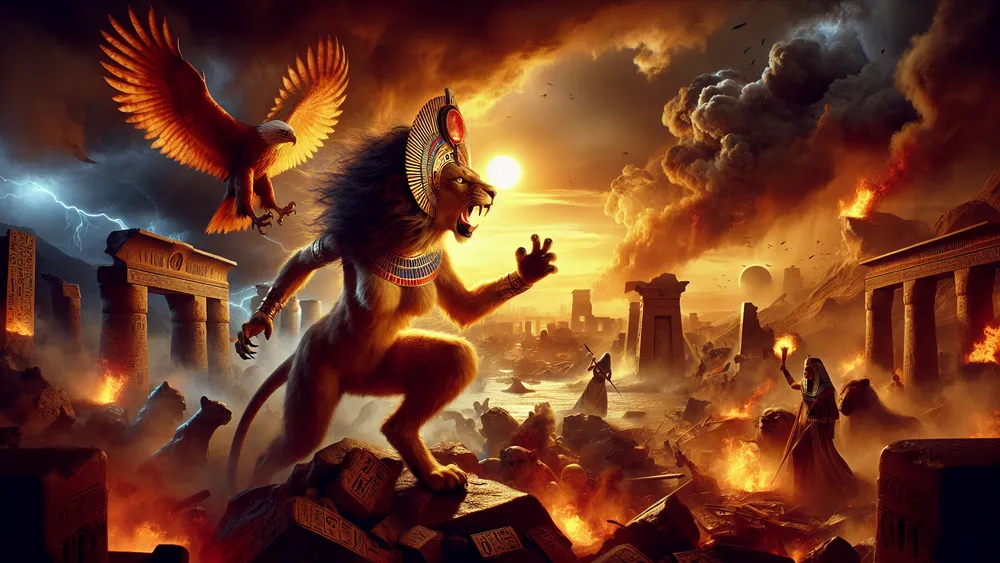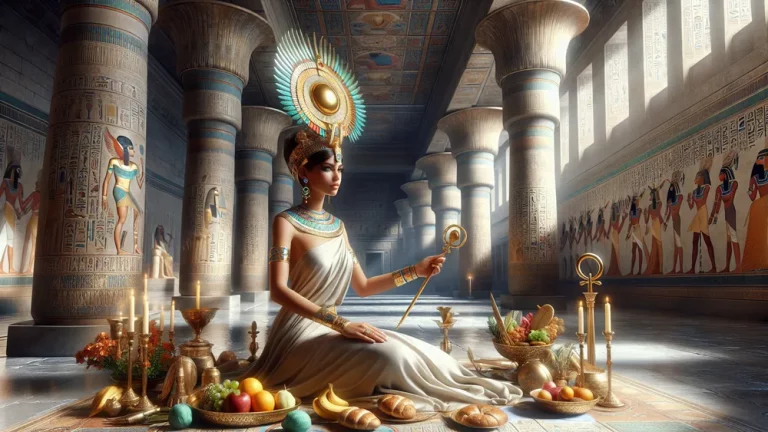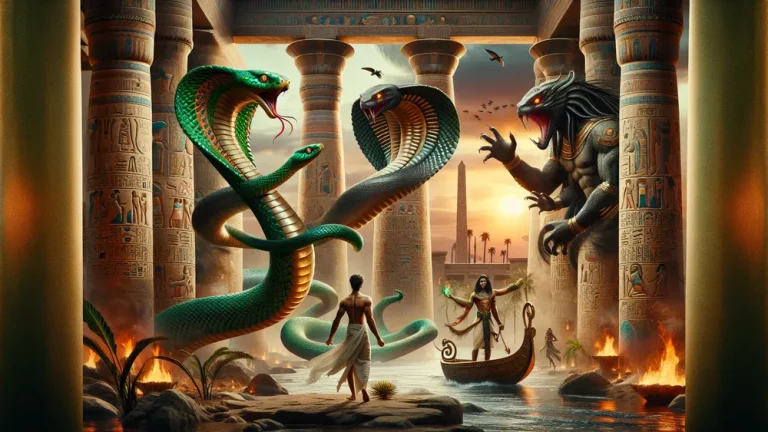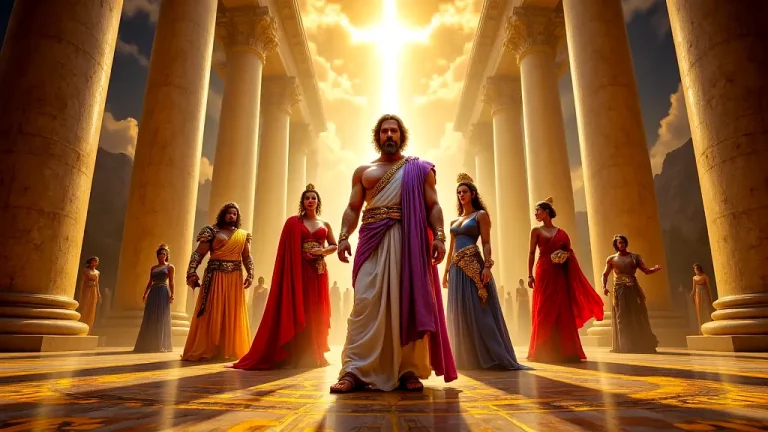The Tale Of The Destruction Of Mankind In Egyptian Mythology
Picture yourself in the middle of old Egypt, full of gods, stories, and legends that changed every part of life. One of the most interesting and big stories from this rich set of myths is the story of the Destruction of Mankind. This story, part of the culture and religion of old Egypt, talks about a time when the sun god Ra wanted to punish humans because they disobeyed.
Key Points:
- The Tale of the Destruction of Mankind is a prominent story in Egyptian mythology involving Ra, Hathor/Sekhmet, and other gods.
- Ra decided to punish humanity for rebelling, leading to Hathor transforming into Sekhmet to bring destruction.
- Other gods intervened to save humanity, emphasizing themes of divine justice, punishment, and mercy in ancient Egyptian culture.
- The myth influenced rituals and artistic expressions, reflecting the beliefs and values of the time.
- Symbols like the sun, lioness, and red-dyedin beer carry significance in conveying themes of balance and order in the story.
- The ongoing impact of the myth is seen in modern interpretations and its study in Egyptology, offering a lens into ancient Egyptian beliefs and society.
When we go through this blog, look at how this story started, the main people in it, and what it did to Egyptian society.
From the angry change of the goddess Hathor into the fierce lioness called Sekhmet to the later action of other gods to save humans, this story shows a strong picture of godly justice, kindness, and the mixed relationship between gods and people. Come with us and see the deep layers of this old story and find out what it left behind in both old and new times.
The Tale Of The Destruction Of Mankind: Overview and Key Facts
| Key Point | Description |
|---|---|
| Story Name | The Tale of the Destruction of Mankind |
| Origins | Ancient Egyptian stories |
| Main Source | Book of the Heavenly Cow |
| Main Gods Involved | Ra, Hathor/Sekhmet, other gods |
| Humans Rebel | Humans go against Ra, which makes him decide to punish them |
| Ra’s Choice | Ra decides to send Hathor to become Sekhmet and destroy people |
| Hathor/Sekhmet’s Part | Hathor changes into Sekhmet and causes trouble for mankind |
| Solution | Other gods step in, Ra stops the destruction, and people are spared |
| Cultural Importance | Shows themes of godly justice, punishment, and kindness in Egyptian culture |
| Effect on Rituals | Influenced rituals and religious practices in ancient Egypt |
| Artistic Impact | Many artists looked to these stories. |
Where the Story Comes From
To really know the story of the Destruction of Mankind, it is important to understand where it started and what was happening when it was made. We will examine the background and sources of this interesting story.
Background Info on the Myth
The Tale of the Destruction of Mankind started when ancient Egypt was a successful place that had strong religious beliefs. During this time, pharaohs were seen as divine rulers and go-betweens for gods and people. This idea made the importance of myths strong, explaining natural and social events. The myth shows how the ancient Egyptians saw things, where gods had huge control over people’s destiny, and divine justice was big.
The Tale of the Destruction of Mankind in ancient Egypt was a crucial myth that reflected the strong religious beliefs, divine rulership of pharaohs, and the immense influence of gods on people’s lives and society.
Sources of the Story
The main source of the story of the Destruction of Mankind is the Book of the Heavenly Cow, an old Egyptian text that gives a full story of the tale. This text is important because it not only tells the story but also shows the religious beliefs and practices of that time.
See the Book of the Heavenly Cow as an old book that was used to understand the gods’ will and how they related to people. Other key sources are different pyramid texts and coffin texts, which also talk about the myth, but in different ways and with different details.
In these texts, you can find different versions of the story. Each one gives a different view of what happened. For example, while the Book of the Heavenly Cow gives a full story, the pyramid texts might have only parts or hints about the myth. These differences are like reading different editions of a popular book, where some might have extra chapters or different endings. To help you see these sources, here is a table comparing the different texts and their variations:

| Source | Explanation | Differences |
|---|---|---|
| Book of the Heavenly Cow | Main source with a full story of the myth | Full narrative, includes Ra’s decision and Hathor/Sekhmet’s role |
| Pyramid Texts | Old writings found in pyramids | Parts and hints, focus on divine justice and world order |
| Coffin Texts | Writings on coffins | Hints at the myth, focus on the lessons and divine punishment |
These sources together give a better understanding of the myth, showing its importance and the different ways it was seen and kept in old Egyptian culture.
What Happens in the Story
Since we talked about the main characters, we should now look at what happens in this interesting story.
The Humans’ Rebellion

In the mythological narrative of ancient Egypt, the rebellion of mankind against Ra represents a big and important event. When Ra, the sun god, gets older, he connects less with people. His rule, once watchful and kind, now feels detached and far. This growing distance between Ra and people makes them unhappy and feeling left out. They start to think Ra doesn’t care about their needs.
This unhappiness leads to an organized rebellion. They share their complaints, and together, they challenge Ra’s authority. They voice their dissent, expressing betrayal and questioning if Ra should rule.
This defiance is new, the first big break between gods and humans in Egyptian stories. The rebellion is not just a physical act but also a symbolic rejection of the order that Ra stands for. The rebellion shows boldness against divine will. The humans’ uprising directly goes against Ra, who was seen as the unassailable ruler of gods and creator of life.
This revolt shows a big change in power and faith dynamics. Reverence for Ra turns into a confrontational stance, seeking to hold the god responsible for his perceived failings.
This human insurrection is a crucial part of the story that moves the myth forward. It sets up what Ra and other deities will do next, which highlights the delicate balance between divine power and human freedom.
Ra’s Decision to Wipe Out Mankind
In response to the unprecedented rebellion of humanity, Ra faces a moment of deep trouble and thinking. As the supreme deity and creator, Ra’s authority has never before been questioned so openly and defiantly. The rebellion hits his core divine identity and rule, making him act strongly to bring back order and show his dominance. Feeling deeply betrayed by the very beings he created, Ra sees their uprising as an unacceptable challenge to his rule and a disruption of the cosmic order.
Ra calls a meeting with the other gods to talk about what to do about humanity’s uprising. This meeting of gods shows how serious things are and that they need to decide together. Ra talks about his hurt and shock, saying they need to punish humans to reestablish his authority and stop future rebellions. Because he wants to show that divine power can’t be challenged, he decides to wipe out mankind, to show gods are above humans.
The other gods, although seeing how serious the rebellion is, also know what it means. But they agree with Ra that they need to show force. Ra’s decision to send Hathor, who turns into the fierce Sekhmet, shows his resolve to punish humans. Sekhmet, known for her fierce destruction, shows the harsh side of divine justice Ra thinks is needed to end the rebellion and bring back order.
Hathor/Sekhmet’s Role in the Chaos

Hathor’s transformation into Sekhmet represents a big and important moment in the myth, showing the fierce and never-giving-up sides of divine punishment. Hathor, who was the goddess of love, beauty, and joy, changes into Sekhmet, the lioness goddess of war and destruction, because Ra commands it. This change shows that gods can be many different things. Hathor turning into Sekhmet proves gods can create and destroy.
As Sekhmet, Hathor becomes the tool of Ra’s anger, sent to earth to stop the rebellion and bring back cosmic order. When Sekhmet is on earth, there is a time of chaos and killing never seen before. She destroys the human population with fierce brutality.
The myth says Sekhmet rampages across the land, leaving destruction everywhere, with blood flowing freely and the earth soaked in her fury. This scene vividly shows divine punishment, highlighting how severe Ra’s response to the rebellion is.
In this story, Sekhmet is not only a destroyer but also a symbol of the terrifying power that the gods have. Her relentless chase of the rebellious humans is a grim reminder of what happens when divine authority is defied. The imagery of Sekhmet’s destruction—rivers of blood and dead bodies everywhere—shows the catastrophic impact of divine anger.
How It All Gets Resolved
As Sekhmet’s devastating rampage reaches its peak, the gods see that they need to act fast to stop the complete destruction of humanity. Her destruction has gone far beyond what Ra wanted, threatening the world’s balance. The gods gather again to plan how to calm Sekhmet and save the rest of mankind. Their plan shows the balance of justice and mercy that is key in Egyptian mythology.
The gods’ answer is clever and symbolic. Knowing Sekhmet’s endless hunger for blood, they make a lot of beer and dye it red, so it looks like blood. This trick depends on Sekhmet’s bloodlust to end her destructive spree. They pour the red beer over the battlefield, making it look like a river of blood. The scene is set up so well that Sekhmet, in her wild state, will be fooled.
Sekhmet, driven by her unquenchable thirst, drinks the red beer greedily. The beer quickly takes effect, dulling her senses and calming her anger. When she goes from wild destruction to calm intoxication, the change is quick and effective. Sekhmet, once a terrifying force of divine wrath, is now harmless, and her bloodlust is satisfied. This moment of trickery and its success shows the gods’ wisdom and cleverness, proving that brainpower can win over brute force.
As Sekhmet’s rage dies down, she slowly changes back to her original form as Hathor, the gentle and loving goddess. Hathor’s return means balance is restored and harmony is back in the world. This change is not just physical but also a deep shift in the cosmic order. The story ends with a strong message: even divine punishment must be balanced with compassion and wisdom. By stepping in, the gods show the principle of Ma’at, meaning justice must be balanced with mercy to keep cosmic harmony.
Symbols and Big Ideas
Since we have looked at the big events and people in the story, let’s look into what the symbols mean and why they are important. These symbols give the myth its long-lasting importance.
Symbols in the Story
The story about the destruction of people is full of symbols with deep importance in old Egyptian culture. Consider the sun, which Ra shows as a symbol of life, authority, and divine power, lighting up the world and keeping things in order. The lioness, which Sekhmet shows, symbolizes fierce protection and destructive power, showing the two-sided nature of gods. The red-dyed beer, used to calm Sekhmet, represents cunning and turning chaos into peace. These symbols are not just parts of the story but are filled with meanings that connect with the values and beliefs of old Egyptians. Here is a list of key symbols and their meanings:

- Sun (Ra): Life, authority, divine power.
- Lioness (Sekhmet): Fierce protection, destructive power.
- Red-Dyed Beer: Cunning, change from chaos to peace.
Main Ideas in the Tale
The story about the destruction of people is full of themes that connect deeply with old Egyptian beliefs and values. Consider divine justice. It is like a ruler making sure laws keep order. In this story, Ra’s choice to punish humans shows the need for balance and punishment when chaos threatens peace. Punishment is seen in Sekhmet’s destructive run, which reminds of the consequences of going against godly authority.
But when the other gods step in to calm Sekhmet, it brings in the idea of kindness, showing that even with big punishment, kindness and balance are needed. These themes match the old Egyptian idea of Ma’at, which means truth, balance, and world order, which was very important to their view of the world and how they governed.
FAQs
1. What is the Book of the Heavenly Cow?
The Book of the Heavenly Cow is an ancient Egyptian text that recounts the tale of the destruction of mankind and the subsequent restoration of order by the gods.
2. Who is Sekhmet in Egyptian mythology?
Sekhmet in Egyptian mythology is a warrior goddess and the goddess of healing, often depicted as a lioness.
3. What is the significance of the destruction of mankind in the myth?
The significance of the destruction of mankind in the myth lies in its illustration of divine justice and the balance between punishment and mercy in ancient Egyptian beliefs.
4. How does the tale reflect ancient Egyptian beliefs and values?
The tale reflects ancient Egyptian beliefs and values by illustrating themes of divine justice, punishment, and mercy, which were central to their worldview.







